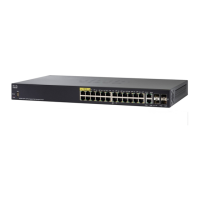Remote Network Monitoring (RMON) Commands
Cisco Sx350 Ph. 2.2.5 Devices - Command Line Interface Reference Guide 1012
51
• type {absolute | delta}—(Optional) Specifies the method used for sampling
the selected variable and calculating the value to be compared against the
thresholds. The possible values are:
- absolute—Specifies that the selected variable value is compared
directly with the thresholds at the end of the sampling interval.
- delta—Specifies that the selected variable value of the last sample is
subtracted from the current value, and the difference is compared with
the thresholds.
• startup {rising | rising-falling | falling}—(Optional) Specifies the alarm that
may be sent when this entry becomes valid. The possible values are:
- rising—Specifies that if the first sample (after this entry becomes valid)
is greater than or equal to rising-threshold, a single rising alarm is
generated.
- rising-falling—Specifies that if the first sample (after this entry becomes
valid) is greater than or equal to
rising-threshold
, a single rising alarm is
generated. If the first sample (after this entry becomes valid) is less than
or equal to falling-threshold, a single falling alarm is generated.
- falling —Specifies that if the first sample (after this entry becomes valid)
is less than or equal to falling-threshold, a single falling alarm is
generated.
• owner
name
—(Optional) Specifies the name of the person who configured
this alarm. (Valid string)
Default Configuration
The default method type is absolute.
The default startup direction is rising-falling.
If the owner name is not specified, it defaults to an empty string.
Command Mode
Global Configuration mode
Example
The following example configures an alarm with index 1000, MIB object ID D-Link,
sampling interval 360000 seconds (100 hours), rising threshold value 1000000,

